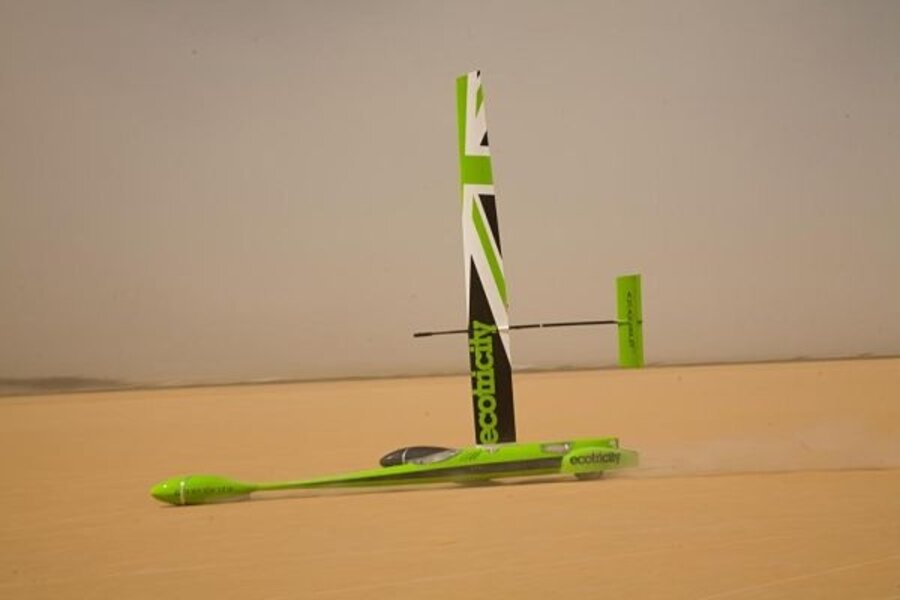Wind-powered car sets speed record, but gimme a wind wagon any day
Over the weekend, an odd looking "car" sped into the record books. The Greenbird, a wind-powered vehicle, blew across Nevada's Ivanpah Lake (it should be called Ivanpah dirt patch) at 126.1 miles an hour.
The car, built mostly from carbon-fiber composite materials and looking nothing like your mama's minivan, beat the previous record by about 10 miles an hour. The craft was designed, built, and driven by one Richard Jenkins, from Britain.
But the good Mr. Jenkins may, repeat, may, have nothing on one Sam Peppard, late of Kansas City. Very late. In 1860, on account of a shortage of horses and with lots of time on his hands, Mr. Peppard designed and built a "wind wagon." Peppard's Folly the neighbors called it. You can read more of the tale here.
According to the newspapers of the day, the wagon typically hustled along the prairie at the breakneck pace of 15 miles an hour. Occasionally it might hit 40.
But as everyone knows, you couldn't believe everything you read in the newspapers back then. So Arizona State University geographer, climate specialist, and weather-history kahuna Randy Cerveny is hoping to test the concept in the field with a full-scale replica next year.
This, according to a chat we had in his office at the university not long ago as we wound down a conversation on weather extremes.
A word about Dr. Cerveny. By his own description, "I'm one of the more eclectic people" in the climate and weather world. "I do tons of strange stuff."
How strange? When not making a bid to become the Thor Heyerdahl of the Great Plains, try "weather detective."
"I did some stuff for the [Defense Department] on weather associated with prison escapes," he says. "Is there a specific kind of weather that you would be more likely to conduct a successful prison escape with?"
He's written one book on weather extremes, and has another due out this year.
Three years ago, he inadvertently landed a job as "rapporteur" for the World Meteorological Organization's Commission on Climatology.
He and some colleagues had noted the US's approach to archiving records of its wildest weather -- complete with a scientific panel to help sort out messy issues like: Was the anemometer badly calibrated? Did someone accidentally drop the thermometer in a pot of hot water before someone else took the temperature reading? In other words, are these readings legit?
They suggested in a paper in the Bulletin of the American Meteorological Society that with all the interest in climate change and weather extremes globally, maybe the WMO should set up something similar. You can find a PDF of the paper here.
The WMO didn't wait for the paper to be published. In 2006 it "volunteered" him to maintain the WMO's archive. If you want to find information about the world's coldest or hottest temperatures, or the strongest tornado ever recorded anywhere on the planet, the web site he maintains is the go-to place.
Peppard's Folly
While he was researching one of his books, he says, Peppard's Folly came to his attention.
"He sailed from Kansas City all the way to Ft. Kearny on the Platte River, then down to within 50 miles of Denver," Cerveny recounts. Unfortunately, a dust devil splintered the wagon. Peppard and his crew had to walk the rest of the way to Denver.
Cerveny says he was captivated by Peppard's story. Why? "He sailed the wrong way. The prevailing winds across the Great Plains go from west to east," he explains.
And none of the newspaper articles describing the feat mentioned anything about tacking the wagon, merely following the Oregon Trail.
Cerveny and some students built a half-scale model, based on the best design information they could find. It wasn't easy. Some of the articles described a steering mechanism that was physically impossible to achieve, then or now. So Cerveny & Co. came up with a suitable work-around.
Once the wagon was finished, he recalls, "I thought: This thing will need a lot of wind to run." But he found that the 40-pound mock-up (the Dust Devil 1) could readily climb a hill in 15 mile-an-hour wind. Accounts from back in the day said the original wind wagon needed 300 pounds of ballast to keep its wheels on the ground.
Now, for the full-scale model
Since the half-scale trial, Cerveny has landed a set of 1860s steel-rimed wheels and axles. He and some grad students are building a full-scale model now (the Dust Devil 2), with an eye toward testing it this summer.
If all goes well, he and his crew aim to set sail from Kansas City during the spring of 2010, the 150th anniversary of Peppard's "cruise," and follow the Oregon Trail, as Peppard did.
Any science here? Some. The wagon will carry weather instruments. From a climatology standpoint, the prevailing winds blow in precisely the wrong direction to make the crossing. "We're trying to find out how these people could do it," he says.
And who's paying for all this? So far, it's all volunteer work. A university alum donated the wheels. Cerveny adds that he might look for some corporate sponsors. The big square sail will have a lot of room for logos. Hmmm. Sir Richard Branson and Virgin Prairie Schooner?
This could be the start of a new sub-sub-sub discipline in science. Archeo-resconstructo-climatology? Or climo-reconstructive archaeology? Whatever, it's all in the spirit of historical reconstructions with a dash of science thrown in.





